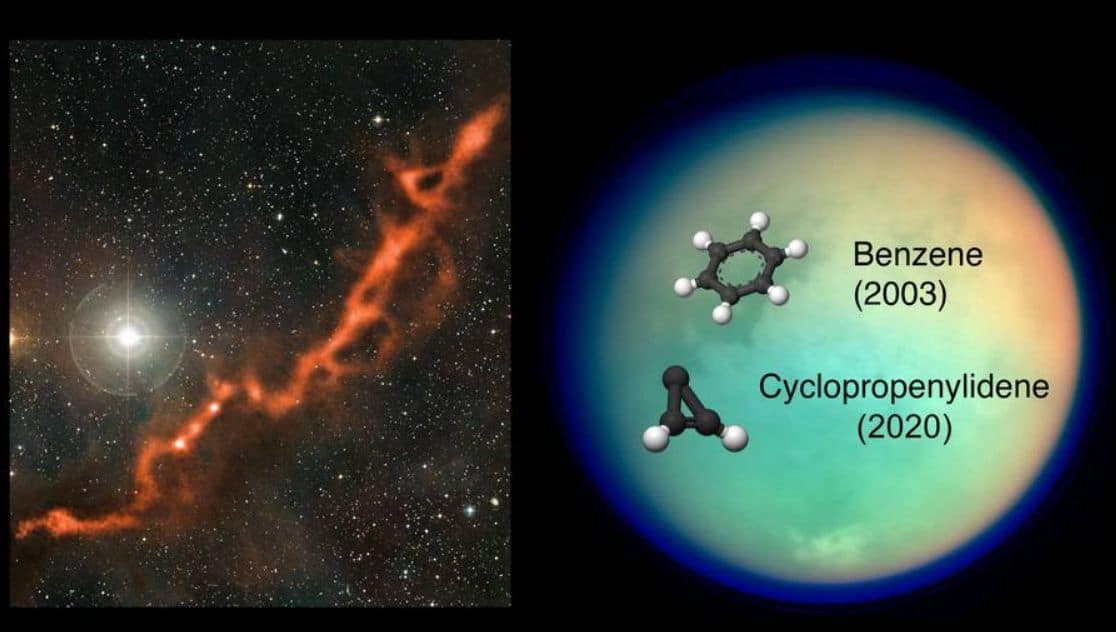The discovery of C3H2 in Saturn’s moon atmosphere may be an indication of life, since its conditions are very similar to Earth millions of years ago
NASA experts have just found a unique finding in the universe: a molecule in Titan’s atmosphere, Saturn’s largest moon, that has never been detected in any other atmosphere before. This is cyclopropenilidene or C3H2, a simple carbon-based element that may be the precursor to more complex compounds that could be part of a hypothetical life signal. Or, put another way, a sign that there may be some kind of living being that’s generating it.
Last year, Amanda Hendrix, one of the leaders of NASA’s Ocean World Exploration Program, explained that Titan had a good chance of being the first system beyond Earth where some way of life could be found. In her reasoning, Hendrix explained that this moon has an atmosphere four times denser than Earth’s, clouds, rains, lakes, rivers, and even underground saltwater oceans. Its features were ideal for harbouring some kind of extraterrestrial life.
The main difference in its atmosphere from ours is that, although it is mainly made up of nitrogen like Earth’s, it also has methane. But it is precisely this element that has aroused the curiosity of the experts: when the molecules of methane and nitrogen break when they come into contact with the sun’s rays, their atoms end up forming a complex network of organic chemistry that experts do not yet know how to explain. For that reason, NASA already sees it as an ideal place to find some kind of life.
Now, a few months after Hendrix’s statements, other NASA colleagues have managed to find the presence of C3H2 in its atmosphere. Thanks to the ALMA telescope (Atacama Large Millimeter/submillimeter Array) located in Chile, experts managed to find Cyclopropenylidene, a study they have presented in the journal ‘Astronomical Journal’. Until now, astronomers had only been able to find this molecule in gas clouds and dust located between different star systems places excessively cold to facilitate these chemical reactions. But what was found on Titan may have a different meaning.
“When I realized I was looking at cyclopropenylidene, my first thought was, ‘Well, this is really unexpected, ” said Conor Nixon, a planetary scientist at NASA’s Goddard Space Flight Center in Greenbelt, Maryland, who led the search for ALMA. “We’ll be looking for bigger molecules than C3H2, but we need to know what’s happening in the atmosphere to understand the chemical reactions that lead complex organic molecules to form and rain down to the surface,” explained Melissa Trainer, NASA Goddard astrobiologist and Principal Investigator of Dragonfly, the mission that will analyze the composition of Titan’s surface.
As NASA explains, cyclopropenylidene is the only ‘cyclic’ or closed-circuit molecule, along with benzene, found in Titan’s atmosphere. These molecules are important because they form the backbone rings for the nucleobases of DNA, the complex chemical structure that carries the genetic code of life, and also RNA, the other basic compound for the functions of life. “The cyclic nature of C3H2 opens up this extra branch of chemistry that allows you to build these biologically important molecules,” said Alexander Thelen, Goddard’s astrobiologist who worked alongside Nixon.
Titan, the largest of Saturn’s 81 moons, has become a mystery to the researchers. Many of its characteristics are similar to earth’s, starting with the size and composition of much of its atmosphere, which makes experts think there maybe life. “We’re trying to find out if Titan is habitable. So we want to know what compounds from the atmosphere get to the surface, and then, whether that material can get through the ice crust to the ocean below, because we think the ocean is where the habitable conditions are,” says Rosaly Lopes, Titan-expert scientist at NASA’s Jet Propulsion Laboratory in Pasadena, California.
The types of molecules that might be settled on Titan’s surface could be the same ones that formed the basic components of life on Earth. Scientists suspect that the conditions on our planet at the beginning of its history, between 3.8 and 2.5 billion years old, when methane filled Earth’s air rather than oxygen, may have been similar to Titan’s today. For that reason, scientists strive to understand what is happening in Saturn’s moon atmosphere. Finding C3H2 may be an indication of life on Titan.
